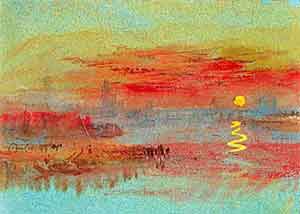Spectacles provide clue to Turner’s visual style

Francesco Carelli
Professor Family Medicine, Milan, Rome, Ankara, Cluj-Napoca
Towards the end of his life Turners eyesight began to fail, and from the late 1830’s onwards his colouring becomes uncertain with him tending to paint too brightly. Richard Liebreich writing in 1872 and defending Turner, wrote:
“According to my opinion, his manner is exclusively the result of a change in his eyes, which developed itself during the last twenty years of his life. In consequence of it the aspect of Nature gradually changed for him, while he continued in an unconscious, I might almost say in a naïve manner, to reproduce what he saw. And he reproduced it so faithfully and accurately, that he enables us distinctly to recognize the nature of the disease of his eyes, to follow its development step by step, and to prove by an optical contrivance the correctness of our diagnosis. By the aid of this contrivance we can see Nature under the same aspect as he saw and represented it.”
Another more recent assessment is by James McGill, as reported by Maev Kennedy in the Guardian in 2003.
“Mr McGill is convinced Turner was slightly colour-blind, and this particularly affected his perception of red and blue. “The blues are all wrong, either too dark or too bright, and the reds get stronger and stronger, which is exactly what you would expect. And I have no doubt that later in life he had untreated cataracts, which would have made the centre of his field of vision very blurred, with some objects at the edges in focus – and with exactly that effect of dazzling shimmering light we see in the paintings.”
“With the type of cataract which I believe Turner had, it is quite possible to see foggily through the cataract, until you are look ing directly into bright light. Then you’re in trouble, because all you can see is the dazzle – and that’s what we get with Turner.”
Vision problems of painters and poets such as van Gogh (poisoned from paints he ate), Cezanne (myopic, refused to wear glasses!) and John Milton, (who went blind), can be aesthetic plus factors, argues Patrick Trevor-Roper, in his book, “The World Through Blunted Sight.” For instance, Trevor-Roper maintains that people whose primary input and output modes are visual, literary and mathematic tend to be myopic and thus exhibit a myopic personality. Because they can only see well in close-up, their work is characterized by imagery that can be viewed only at close range. The mechanism which causes shortsightedness (an elongated eyeball) also influences perception of color: reds look more precisely defined. Cataracts can change the way we see color by blurring and reddening our vision. After Monet had his cataracts operated on, he found his most recent work ghoulishly colored and lacking in blue. He went on to produce a few blue and blue-green-hued masterpieces. Georgia O’Keefe, who suffered from age-related macular degeneration, gradually lost the center of her field of vision. She continued to paint, however, with what was left of her peripheral vision. Some of the works she made during the years of her waning eyesight are among her most powerful.
The debate over Turner’s eyesight has been revived by the argument over a battered pair of Victorian spectacles auctioned at Sotheby’s and another in exhibition at Tate Britain and the exhibition……
Consultant opthalmic surgeon James McGill has been studying Turner’s work for years, and sees a potential patient for surgery which could have changed the course of art history. Both pairs were Turner’s, evidence of his deteriorating eyesight.
Turner’s blazing scarlet, gold and black night scenes, wild seas and piercing blue skies, hazes of smoke and cloud, and the Venetian paintings where solid objects dissolving into a dazzle of golden light.
The colour and light mesmerised the critic John Ruskin, and bewildered his contemporaries. The Morning Herald described it in 1829 as “colouring run mad”, and the Athenaeum in 1842 sniffed: “This gentleman had, on former occasions, chosen to paint with cream, or chocolate, or currant jelly – here he uses his whole array of kitchen stuff.”
One pair of spectacles turned out to be minus 2.5, while the other ones, now on loan to the Tate, are plus three and plus four. However, It should be no conflict: the fist spectacles were an everyday pair, with the Ruskin pair used in later life for close work.
These theories do not diminish Turner’s genius, because the paintings are superb – but there is no mystery about why he painted that way: he was painting exactly what he saw.

